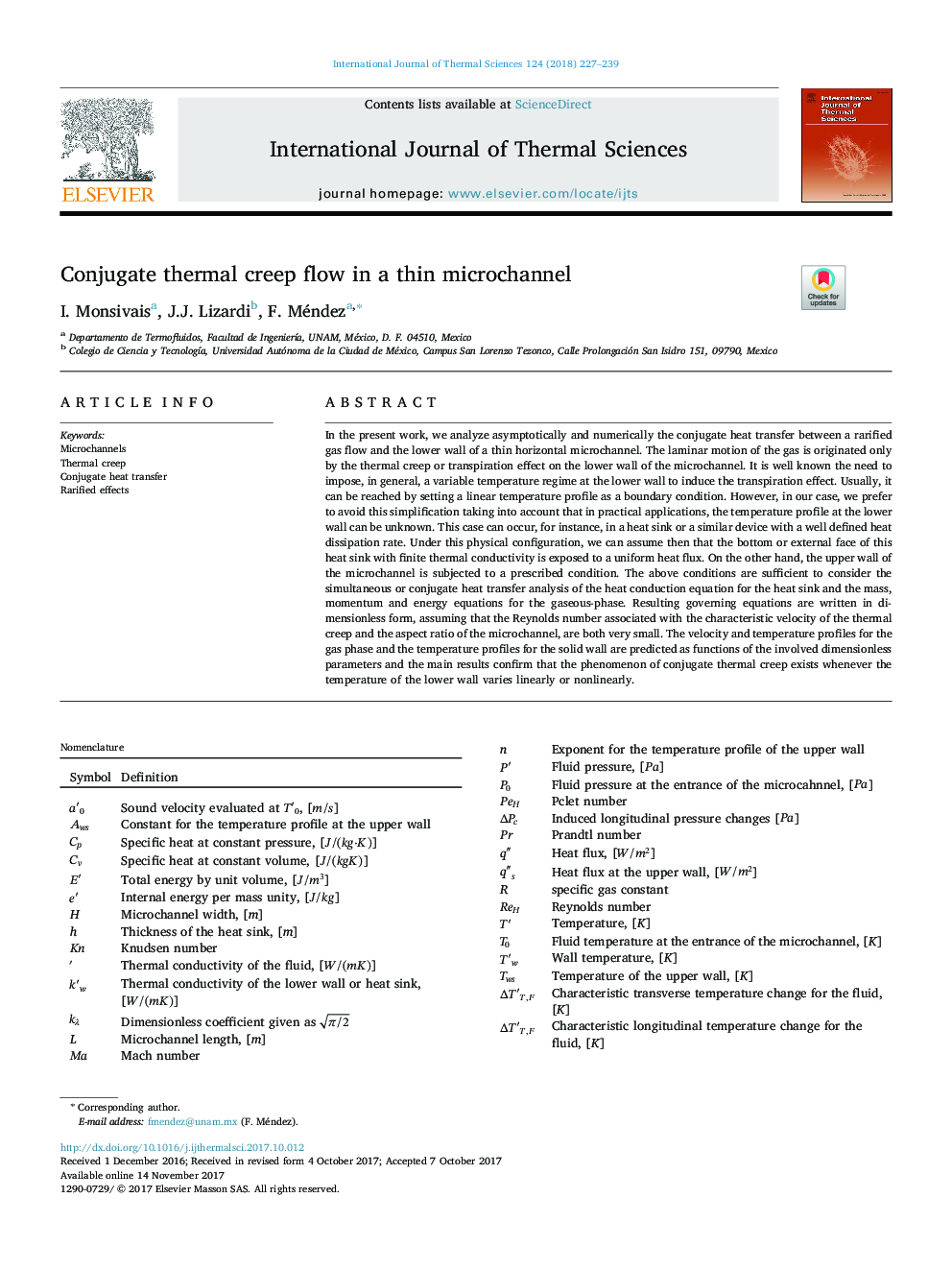| کد مقاله | کد نشریه | سال انتشار | مقاله انگلیسی | نسخه تمام متن |
|---|---|---|---|---|
| 7060863 | 1458698 | 2018 | 13 صفحه PDF | دانلود رایگان |
عنوان انگلیسی مقاله ISI
Conjugate thermal creep flow in a thin microchannel
ترجمه فارسی عنوان
جریان خزش حرارتی در یک میکرو کانال نازک
دانلود مقاله + سفارش ترجمه
دانلود مقاله ISI انگلیسی
رایگان برای ایرانیان
کلمات کلیدی
میکرو کانالها، خزش حرارتی، انتقال حرارت متصل، اثرات متمایز،
ترجمه چکیده
در این مقاله، انتقال حرارت گرمادهی اتصال بین جریان گاز رفع شده و دیواره پایینتر یک میکرو کانال نازک افقی را به صورت معکوس و عددی تحلیل می کنیم. حرکت لامینری گاز تنها از اثر خزش حرارتی یا حرارتی بر روی دیوار پایین میکرو کانال آغاز می شود. به خوبی شناخته شده است نیاز به طور کلی یک رژیم دما متغیر در دیوار پایین تر را تحمیل کرده تا اثر ترشح را ایجاد کند. معمولا، با تنظیم یک پروفیل درجه حرارت خطی به عنوان یک شرایط مرزی، می توان آن را پیدا کرد. با این حال، در مورد ما ترجیح می دهیم از این ساده سازی اجتناب کنیم با توجه به اینکه در کاربردهای عملی، مشخصات دما در دیوار پایین می تواند ناشناخته باشد. این مورد می تواند به عنوان مثال در یک گرمایش گرمایشی یا یک دستگاه مشابه با سرعت تخلیه گرما به خوبی تعریف شود. در زیر این پیکربندی فیزیکی، می توانیم فرض کنیم که چهره پایین و یا خارجی این غرق گرما با هدایت حرارتی محدود، در معرض شار گرما یکنواخت است. از سوی دیگر، دیوار بالا از میکرو کانال تحت شرایطی قرار می گیرد. شرایط فوق به اندازه کافی برای بررسی انتقال همزمان یا انتقال گرما از معادله هدایت گرما برای گرما و معادلات جرم، حرکتی و انرژی برای فاز گاز است. نتیجه گیری معادلات حاکم در فرم بدون بعد نوشته شده است، فرض کنید که تعداد رینولدز با سرعت مشخصی از خزش حرارتی و نسبت عرضی میکرو کانال، هم بسیار کوچک است. پروفیل های سرعت و دما برای فاز گاز و پروفیل های دما برای دیوار جامد به عنوان توابع پارامترهای بدون بعد مورد پیش بینی قرار می گیرند و نتایج اصلی تایید می کنند که پدیده خزش حرارتی کنجد هر زمان که دمای دیوار پایین تر از خطی یا غیر خطی متفاوت باشد .
موضوعات مرتبط
مهندسی و علوم پایه
مهندسی شیمی
جریان سیال و فرایندهای انتقال
چکیده انگلیسی
In the present work, we analyze asymptotically and numerically the conjugate heat transfer between a rarified gas flow and the lower wall of a thin horizontal microchannel. The laminar motion of the gas is originated only by the thermal creep or transpiration effect on the lower wall of the microchannel. It is well known the need to impose, in general, a variable temperature regime at the lower wall to induce the transpiration effect. Usually, it can be reached by setting a linear temperature profile as a boundary condition. However, in our case, we prefer to avoid this simplification taking into account that in practical applications, the temperature profile at the lower wall can be unknown. This case can occur, for instance, in a heat sink or a similar device with a well defined heat dissipation rate. Under this physical configuration, we can assume then that the bottom or external face of this heat sink with finite thermal conductivity is exposed to a uniform heat flux. On the other hand, the upper wall of the microchannel is subjected to a prescribed condition. The above conditions are sufficient to consider the simultaneous or conjugate heat transfer analysis of the heat conduction equation for the heat sink and the mass, momentum and energy equations for the gaseous-phase. Resulting governing equations are written in dimensionless form, assuming that the Reynolds number associated with the characteristic velocity of the thermal creep and the aspect ratio of the microchannel, are both very small. The velocity and temperature profiles for the gas phase and the temperature profiles for the solid wall are predicted as functions of the involved dimensionless parameters and the main results confirm that the phenomenon of conjugate thermal creep exists whenever the temperature of the lower wall varies linearly or nonlinearly.
ناشر
Database: Elsevier - ScienceDirect (ساینس دایرکت)
Journal: International Journal of Thermal Sciences - Volume 124, February 2018, Pages 227-239
Journal: International Journal of Thermal Sciences - Volume 124, February 2018, Pages 227-239
نویسندگان
I. Monsivais, J.J. Lizardi, F. Méndez,
